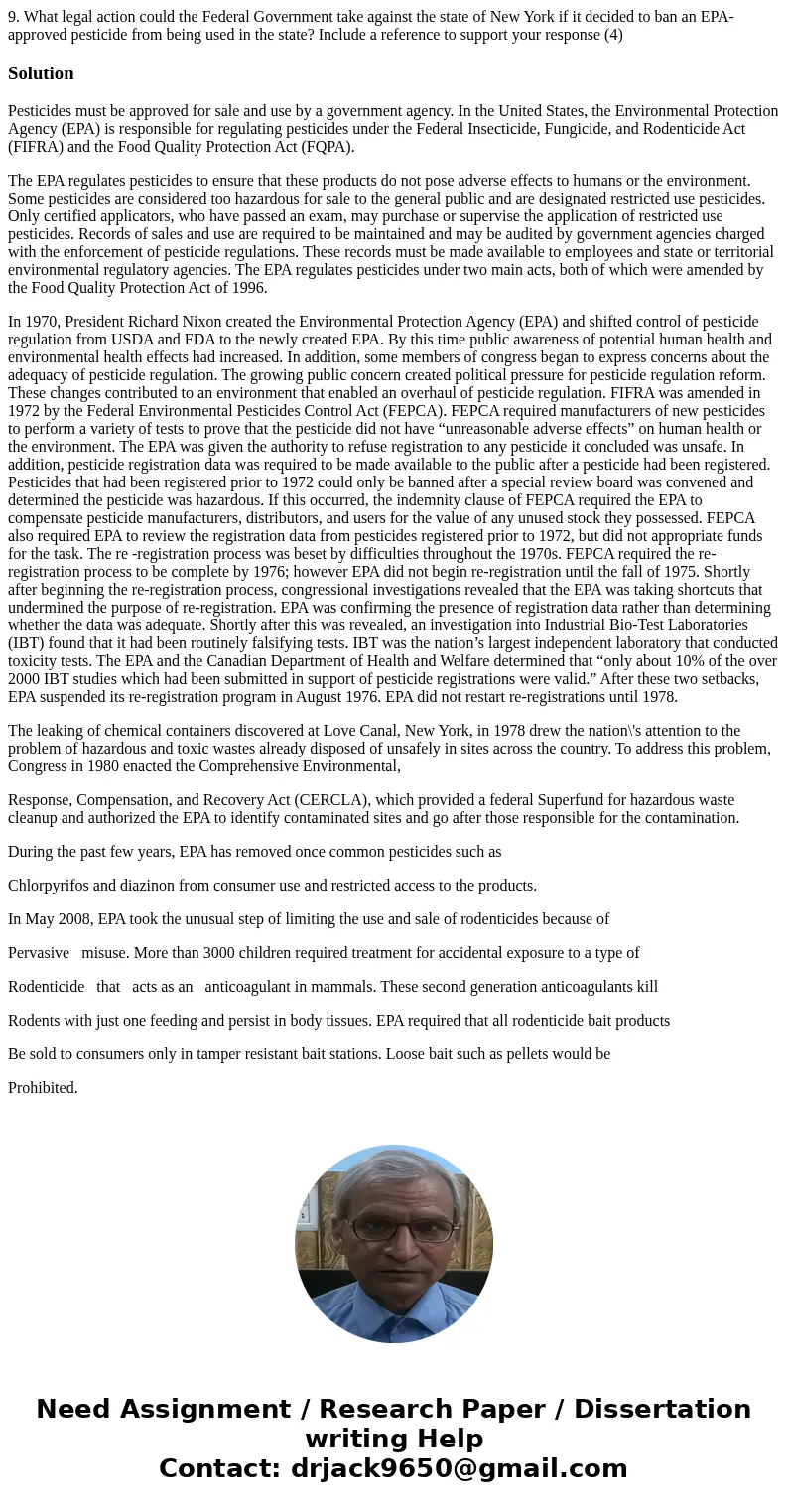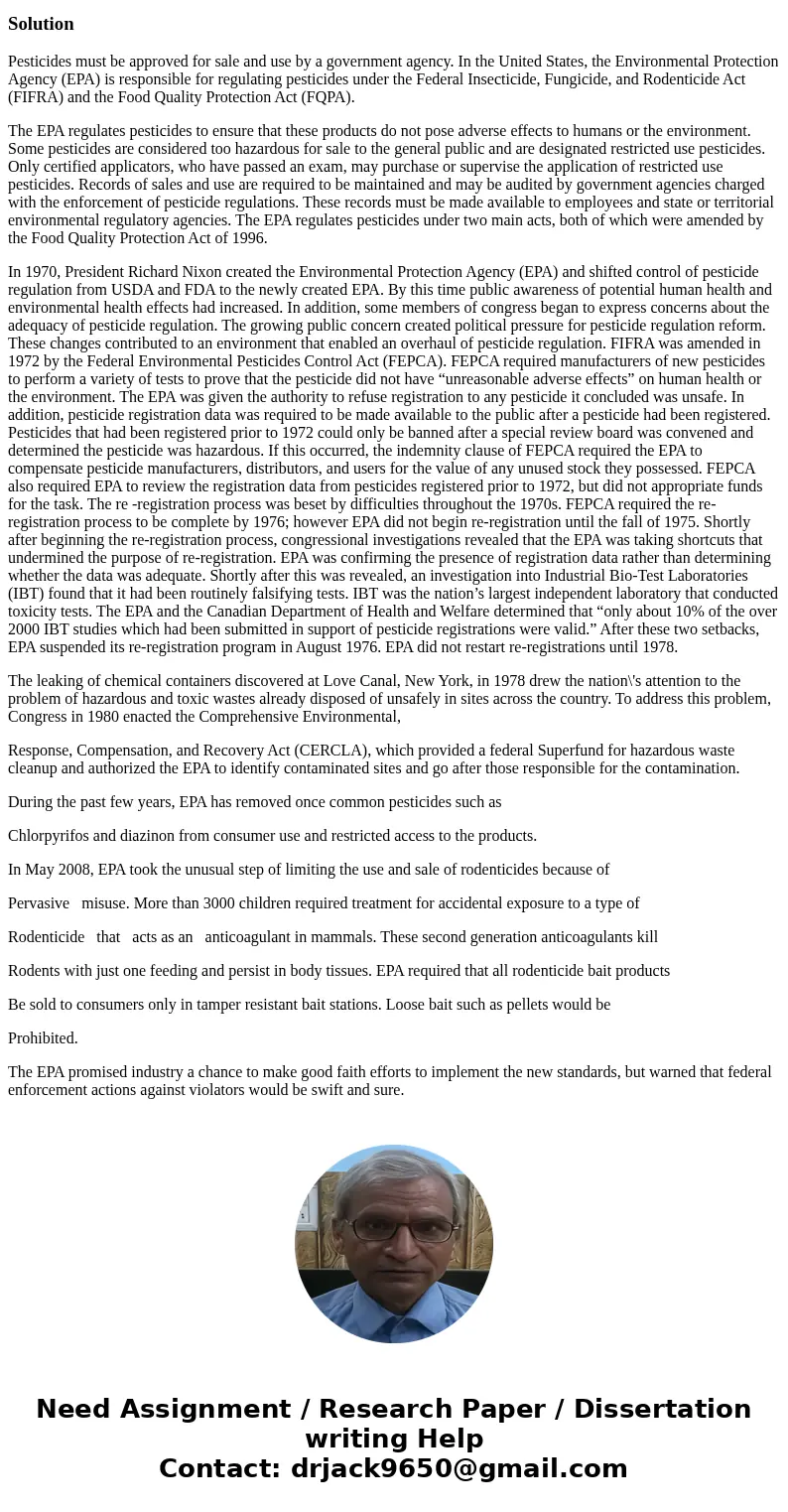9 What legal action could the Federal Government take agains
9. What legal action could the Federal Government take against the state of New York if it decided to ban an EPA-approved pesticide from being used in the state? Include a reference to support your response (4)
Solution
Pesticides must be approved for sale and use by a government agency. In the United States, the Environmental Protection Agency (EPA) is responsible for regulating pesticides under the Federal Insecticide, Fungicide, and Rodenticide Act (FIFRA) and the Food Quality Protection Act (FQPA).
The EPA regulates pesticides to ensure that these products do not pose adverse effects to humans or the environment. Some pesticides are considered too hazardous for sale to the general public and are designated restricted use pesticides. Only certified applicators, who have passed an exam, may purchase or supervise the application of restricted use pesticides. Records of sales and use are required to be maintained and may be audited by government agencies charged with the enforcement of pesticide regulations. These records must be made available to employees and state or territorial environmental regulatory agencies. The EPA regulates pesticides under two main acts, both of which were amended by the Food Quality Protection Act of 1996.
In 1970, President Richard Nixon created the Environmental Protection Agency (EPA) and shifted control of pesticide regulation from USDA and FDA to the newly created EPA. By this time public awareness of potential human health and environmental health effects had increased. In addition, some members of congress began to express concerns about the adequacy of pesticide regulation. The growing public concern created political pressure for pesticide regulation reform. These changes contributed to an environment that enabled an overhaul of pesticide regulation. FIFRA was amended in 1972 by the Federal Environmental Pesticides Control Act (FEPCA). FEPCA required manufacturers of new pesticides to perform a variety of tests to prove that the pesticide did not have “unreasonable adverse effects” on human health or the environment. The EPA was given the authority to refuse registration to any pesticide it concluded was unsafe. In addition, pesticide registration data was required to be made available to the public after a pesticide had been registered. Pesticides that had been registered prior to 1972 could only be banned after a special review board was convened and determined the pesticide was hazardous. If this occurred, the indemnity clause of FEPCA required the EPA to compensate pesticide manufacturers, distributors, and users for the value of any unused stock they possessed. FEPCA also required EPA to review the registration data from pesticides registered prior to 1972, but did not appropriate funds for the task. The re -registration process was beset by difficulties throughout the 1970s. FEPCA required the re-registration process to be complete by 1976; however EPA did not begin re-registration until the fall of 1975. Shortly after beginning the re-registration process, congressional investigations revealed that the EPA was taking shortcuts that undermined the purpose of re-registration. EPA was confirming the presence of registration data rather than determining whether the data was adequate. Shortly after this was revealed, an investigation into Industrial Bio-Test Laboratories (IBT) found that it had been routinely falsifying tests. IBT was the nation’s largest independent laboratory that conducted toxicity tests. The EPA and the Canadian Department of Health and Welfare determined that “only about 10% of the over 2000 IBT studies which had been submitted in support of pesticide registrations were valid.” After these two setbacks, EPA suspended its re-registration program in August 1976. EPA did not restart re-registrations until 1978.
The leaking of chemical containers discovered at Love Canal, New York, in 1978 drew the nation\'s attention to the problem of hazardous and toxic wastes already disposed of unsafely in sites across the country. To address this problem, Congress in 1980 enacted the Comprehensive Environmental,
Response, Compensation, and Recovery Act (CERCLA), which provided a federal Superfund for hazardous waste cleanup and authorized the EPA to identify contaminated sites and go after those responsible for the contamination.
During the past few years, EPA has removed once common pesticides such as
Chlorpyrifos and diazinon from consumer use and restricted access to the products.
In May 2008, EPA took the unusual step of limiting the use and sale of rodenticides because of
Pervasive misuse. More than 3000 children required treatment for accidental exposure to a type of
Rodenticide that acts as an anticoagulant in mammals. These second generation anticoagulants kill
Rodents with just one feeding and persist in body tissues. EPA required that all rodenticide bait products
Be sold to consumers only in tamper resistant bait stations. Loose bait such as pellets would be
Prohibited.
The EPA promised industry a chance to make good faith efforts to implement the new standards, but warned that federal enforcement actions against violators would be swift and sure.


 Homework Sourse
Homework Sourse